![]()
![]()
![]()
Use LEFT and RIGHT arrow keys to navigate between flashcards;
Use UP and DOWN arrow keys to flip the card;
H to show hint;
A reads text to speech;
78 Cards in this Set
- Front
- Back
|
What are some considerations for animals living in an enviroment of wet water? consider high humidity...
|
1. body walls of aquatic animals are thin and permeable
2. ammonia can be diffused directly out of the animal and does not need extra processing to limit water loss as in terrestrial animals 3. fertilization and release of sperm and eggs can be done directly in the water because there is no osmotic pressure or problems with drying 4. water soluble nutrients can be taken up directly by animals (especially salts) 5. photosynthesizing organisms do not need roots and can be small (phytoplankton) 6. problem: water soluble pollutant effect animals to a high degree |
|
|
What are some considerations for animals living in an enviroment of wet water? consider the high density of water...
|
1. no need for rigid skeletal support because water supports the body
2. water supports delicate anatomical structures that would collapse in air 3. filter feeding is possible because water moves constantly so the food comes to the animal a. because water is wet and dense, microscopic free floating phytoplankton and zooplankton live in suspension and suspension-feeding animals can capture food particles as they float by. b. In unsupportive air food particles do not occur in such a high concentration so this is much more difficult (but possible: spiders and webs) |
|
|
What are some considerations for animals living in an enviroment of wet water? consider the high temperature stabilty of water...
|
1. Water temperature is insensitive to short-term temp fluctuations in temperature
2. Water does not experience as huge differences in seasonal temperatures 3. Since all chemistry including metabolism is effected by temperature wide changes in temperature are stressful to animals |
|
|
What are some considerations for animals living in an enviroment of wet water? consider light...
|
iv. Light is distinguished quickly in water
1. Most aquatic primary production (fixation of carbon fron carbon dioxide into carbohydrates generally by photosynthesizing plants, algae, and phytoplankton) is limited to the top 20-50 m. |
|
|
What are some considerations for animals living in an enviroment of wet water? consider oxyden availabilty...
|
v. Water has a low oxygen solubility
1. there is less oxygen per volume than in air and it diffuses much slower than in air. 2. Movement of water enhances gas exchange so sessile (nonmotile) organisms either live in places of high water velocity or have some means of creating water flow |
|
|
What are some considerations for animals living in an enviroment of wet water? consider the viscosity of water...
|
vi. Water is much more viscous than air
1. Animals swimming in water face more resistance (drag) 2. For large animals moving quickly greater drag is due to greater density 3. small animals moving slowly are affected by water’s high viscosity a. effects much more pronounced with a fall in temp that increases viscosity b. water tends to move around rather than through bristly appendages |
|
|
What are some considerations for animals living in an enviroment of wet water? Consider living in fresh water...
|
vii. fresh water
1. more changes to environment (drying up) than salt water 2. fresh water animals are hyperosmotic to their environment and must pump water out 3. less salt availability 4. more variability in pH because there is no bicarbonate ion as there is in salt water |
|
|
What is a metazoan?
|
: multicellular, generally diploid organisms that develop from a blastula
|
|
|
What are the types of metazoan body symmetry? What are the characteristic of each?
|
ii. Metazoan body symmetry is generally of two types, bilateral or radial (and sometimes asymmetrical)
1. Bilateral symmetry: animal posseses a right and left sides that are approximate mirror images of each other a. Bilateral symmetry is often associated with cephalization, which is the concentration of nervous and sensory tissues and organs at one end of the animal, resulting in disting anterior and posterior ends b. Only a cut from the anterior to posterior (long) axis results in a mirror image 2. Radial symmetry: such an animal can be divided into two part by any cut that passes through its center a. Internal anatomies do not necessarily follow the same symmetry |
|
|
What is bilateral symmetry?
|
1. Bilateral symmetry: animal posseses a right and left sides that are approximate mirror images of each other
a. Bilateral symmetry is often associated with cephalization, which is the concentration of nervous and sensory tissues and organs at one end of the animal, resulting in disting anterior and posterior ends b. Only a cut from the anterior to posterior (long) axis results in a mirror image |
|
|
What is radial symmetry?
|
2. Radial symmetry: such an animal can be divided into two part by any cut that passes through its center
a. Internal anatomies do not necessarily follow the same symmetry |
|
|
What does it mean to classify an animal based on developmental patterns? What are the two major developmental groups?
|
c. Classification by developmental pattern: multicellular organisms can be divided into two groups based on the number of distinguishable germ layers formed during embryogenesis
Animals can either be classified as diblastic or triploblastic |
|
|
What are the characteristics of a typical diblastic animal?
|
ii. Diploblastic (double blastic): there are two distinct germ layers
1. Ectoderm: “outer skin” the outermost layer of cells 2. Endoderm: “inner skin” the innermost layer of cells 3. Diploblastic animals may develop tissues or organ associated with the mesoderm area in triploblastic animals despite the absence of this area in embryonic development (such as musculature) |
|
|
What are the characteristics of a typical triploblastic animal?
|
iii. Triploblastic: metazoans with an additional third layer of cells
1. Mesoderm: “middle skin” a layer of cells between the ectoderm and endoderm 2. Triploblastic animals can be further divided into three body plans bases on the presence and development of an internal body cavity independent of the digestive tract (gut) |
|
|
What are the tree body plans associated wiht triploblastic animals?
|
2. Triploblastic animals can be further divided into three body plans bases on the presence and development of an internal body cavity independent of the digestive tract (gut)
a. Acoelomate (a:without, coelom: a hollow space) animals without a body cavity i. The region lying between the outer body wall and the gut is solid and occupied by mesoderm, there is no trace of an internal cavity development as embryo b. Pseudocoelomate are animals with a body plan in which the region between the outer body wall musculature and the endoderm of the gut is a fluid filled cavity i. In some animals this cavity is derived from the blastocoels, an internal space that develops prior to gastrulation c. Coelomates or eucoelomates are animals with a body plan such that they have a true coelom, an internal, fluid filled body cavity lying between the gut and the outer body wall musculature lined with tissue derived from the mesoderm. |
|
|
What are acoelomates?
|
a. Acoelomate (a:without, coelom: a hollow space) animals without a body cavity
i. The region lying between the outer body wall and the gut is solid and occupied by mesoderm, there is no trace of an internal cavity development as embryo |
|
|
What is a pseudocoelomate?
|
b. Pseudocoelomate are animals with a body plan in which the region between the outer body wall musculature and the endoderm of the gut is a fluid filled cavity
i. In some animals this cavity is derived from the blastocoels, an internal space that develops prior to gastrulation |
|
|
What is a ceolomate?
|
c. Coelomates or eucoelomates are animals with a body plan such that they have a true coelom, an internal, fluid filled body cavity lying between the gut and the outer body wall musculature lined with tissue derived from the mesoderm.
i. Coelom formation is formed in one of two ways, and is used to assign coelomates to one of two categories |
|
|
What are the advantages of having a coelom?
|
1. Coelom advantages are
a. that the gut is somewhat independent from muscular or locomotory activities of the body wall b. the animal gains internal space to store digestive organs, gonads, developing embryos c. internal fluids can serve to distribute oxygen, nutrients, hormones d. Can lead to more effective systems of locomotion (hydrostatic skeleton) |
|
|
What are the two groupls of ceolomate animals? Characteristics of each?
|
ii. Protostomes: a group of animals in whom coelom formation occurs by gradual enlargement of a split in the mesoderm (schizocoely)
1. Mouth forms usually from the blastopore 2. Radial cleavage in development a. At a 45 degree angle, and offcenter after the 4 cell stage 3. No twins: development of each cell is determinate 4. Mesoderm from a single cell of the 64-cell embryo 5. Polar lobes formed during first 1 or 2 clevages a. A lobe filled with cytoplasm (and maternal mRNA) 6. Larval Protostomes composed of multicilated cells and downstream particle capture iii. Deuterostome- coelom typically forms through an evagination of the archenteron into the embryonic blasotcoel (enterocoely) |
|
|
What are the characteristics of protstomes?
|
q\\ii. Protostomes: a group of animals in whom coelom formation occurs by gradual enlargement of a split in the mesoderm (schizocoely)
1. Mouth forms usually from the blastopore 2. spiral cleavage in development a. At a 45 degree angle, and offcenter after the 4 cell stage 3. No twins: development of each cell is determinate 4. Mesoderm from a single cell of the 64-cell embryo 5. Polar lobes formed during first 1 or 2 clevages a. A lobe filled with cytoplasm (and maternal mRNA) 6. Larval Protostomes composed of multicilated cells and downstream particle capture |
|
|
What are the characteristics of deuterosomes?
|
iii. Deuterostome- coelom typically forms through an evagination of the archenteron into the embryonic blasotcoel (enterocoely)
|
|
|
What is the function of the hydrostatic skeleton?
|
a. Function of the skeleton is to allow muscles to antagonize (act against), and return to their stretched configuration
|
|
|
What are the requirements for a hydrostatic skeleton?
|
i. The presence of a cavity housing an incompressible fluid that transmits pressure changes uniformly in all directions
ii. That this cavity be surrounded by a flexible outer body membrane so that the outer body wall can be deformed iii. That the volume of fluid in the cavity remain constant iv. That the animal be capable of forming temporary attachments to the substrate, if progressive locomotion is to occur on or within a substrate. v. The presence of two sets of muscles that can act against each other 1. Usually one set of longitudinal and one set of circular muscles 2. The longitudinal muscles allow the animal to elongate 3. The circular muscles allow the animal to return to its original shape |
|
|
What phylum do these characteristics describe?
i. One or more pair of chitinous bristles called setae or chaetae ii. Vermiform- soft bodied, reasonable circular in cross-section and longer than they are wide iii. Metamerism: Bodies consist of a series of repeating segments and organ systems iv. Thin body wall for gas exchange restricts annelids to moist environments v. Excretion via nephridia (little kidneys) |
Phylum Annelida
|
|
|
What Class and Phylum do animals with the below characteristics belong to?
i. Defining characteristic are paired lateral outfoldings of the body wall (parapodia) |
Phylum Annelida
Class Polycheata |
|
|
What are parapodia?
|
paired lateral outfoldings of the body wall (parapodia)
1. Highly vascularized, increase surface area, function in gas exchange 2. Serve locomotory function when stiffened by chitinous support rods called acicula 3. Satae protrude from each parapodium |
|
|
What is the function of acicula?
|
to stiffen parapodia
|
|
|
What are some locmotion characteristics associated with Class Polycheata?
|
vi. Locomotion characteristics
1. Septa allow for independent movement in each section 2. Setae form temporary attachment sites and prevent backsliding 3. Septa btw anterior adjacent segments are often incomplete (perforate) or absent in active burrowing forms allowing a greater volime of coelomic fluid and therefore greater shape changes to be associated with extending and anchoring the penetration organ |
|
|
What Class and Phylum do animals in sublass Errantia belong to? What are the characteristics of this group?
|
Phylum Annelida
Class Polycheata viii. Errant polycheate species (subclass Errantia) are polycheats that are generally active and mobile 1. Parapodia play important role in locomotion, acting as oars. Acicula stiffen and strengthen the parapodia 2. Surface dwellers as well as species that from burrows 3. Well-developed parapodia with accicula and satae 4. A well-developed head equipped with a toothed or jawed protrusible pharynx 5. Mostly carnivorous (but others as well) 6. Some burrowing polycheates lack parapodia |
|
|
What are the characteristics of Sedentaria polycheates?
|
ix. Sedentaria polycheates spend their entire lives in simple burrows in the sediment or in rigid protective tubes
1. Parapodia greatly reduced, modified, or absent as are acicula 2. Most lack a protrusible pharynx (proboscis) 3. Water moved into and out of tube or burro by cilia, rhythmic movements of parapodia, or waves of muscle contraction 4. Feathery appendages at anterior end serve as food capture devices or gills 5. Suspension feeders 6. Some have protonephridia – ultrafiltration of coelomic fluid |
|
|
What are the characteristics of polycheat reproduction?
|
1. Sexual reproduction
2. Gonochronistic (mostly) meaning they have separate sexes 3. Some families especially tube dwelling or sedentary species undergo epitoky: a marked morphological change in prep for sexual activity a. Epitoke: a sexually mature being (male or female) that is highly specialized for swimming and sexual respoduction i. Generated by either asexual budding one segment at a time from the animals posterior (atoke) or remodeling of existing structure 4. External fertilization 5. larvae has 2 rings of cilia called the prototroch (first wheel, at the equator of animal where the mouth is) and telotroch (tail wheel, at the posterior terminal portion of what will be the adult (pygidium)) |
|
|
What is an epitoke?
|
a. Epitoke: a sexually mature being (male or female) that is highly specialized for swimming and sexual respoduction
i. Generated by either asexual budding one segment at a time from the animals posterior (atoke) or remodeling of existing structure |
|
|
What is the larval stage of a polycheate called? characteristics?
|
trochophore
5. larvae has 2 rings of cilia called the prototroch (first wheel, at the equator of animal where the mouth is) and telotroch (tail wheel, at the posterior terminal portion of what will be the adult (pygidium)) a. Prototroch involved in locomotion b. Larva is called a trochophore (wheele-bearer) c. Metatroch (between wheel) forms later |
|
|
What class nad phylum of animals are described by these characteristics?
i. Defining characteristic: Pronouncred cylindrical glandular region of the body (clitellum) that plays an important part in reproduction and Permanent gonads 1. Hermaphroditic 2. The clitellum is a specialized region of the epidermis that secretes a cocoon within which embryos develop. It also secretes mucus that assists in transferring sperm between individuals and albumen to nourish developing larva in the cocoon |
Phylum Annelida
Class Clitellata |
|
|
what is the function of the clitellum?
|
2. The clitellum is a specialized region of the epidermis that secretes a cocoon within which embryos develop. It also secretes mucus that assists in transferring sperm between individuals and albumen to nourish developing larva in the cocoon
|
|
|
What subclass, class, and phylum do eathworms belong to? what are the chatacteristics of this subclass?
|
Subclass Oligocheata
Class Clitellata Phylum Annelida ii. Subclass Oligochaeta (85% of clitellate species) 1. Mostly freshwater (eathrworm is an example) 2. No parapodia 3. Anterior region of body (prostomium) has no conspicuous sensory structures 4. Sparse satea 5. Gas exchange across body wall 6. Locomotion a. Semi-isolated body compartments b. Inner longitudinal muscles c. Outer circular muscles d. Move by peristaltic waves: a series of localized contractions and relaxations of circular and longitudinal muscles, retrograde waves 7. Resporduction a. Hermaphroditic: each individual produces sperm and eggs. Individuals simultaneously exchange sperm and store the sperm in spermathecae (sperm boxes). Egg and sperm are extruded from separate openings into a cocoon. Fertilization is external in the cocoon where embryos develop. b. Asexual: (esp in freshwater species) transverse division of the “adult” forms separate sections and new individuals c. Parthenogenetic: egg develops normally in the absence of fertilization |
|
|
How do oligocheates move?
|
a. Semi-isolated body compartments
b. Inner longitudinal muscles c. Outer circular muscles d. Move by peristaltic waves: a series of localized contractions and relaxations of circular and longitudinal muscles, retrograde waves |
|
|
How do oligocheates reproduce?
|
a. Hermaphroditic: each individual produces sperm and eggs. Individuals simultaneously exchange sperm and store the sperm in spermathecae (sperm boxes). Egg and sperm are extruded from separate openings into a cocoon. Fertilization is external in the cocoon where embryos develop.
b. Asexual: (esp in freshwater species) transverse division of the “adult” forms separate sections and new individuals c. Parthenogenetic: egg develops normally |
|
|
What subclass, class, phylum do leeches belong to? What are some characteristics?
|
Subclass Hirudinea
Class Clitellata Phylum Annelida 1. Defining characteristic: a posterior sucker 2. Mostly freshwater 3. No parapodia, no internal gas exchange organs, no head appendages, no satae 4. Body not separated into compartments 5. Continuous coelomic space is filled with connective tissue; nesebchyme 6. Locomotion: use suckers as anchors, contracts muscles to form a U, then repeat 7. Feed on blood of vertebrates or invertebrates (parasitic) or predators of other invertebrates 8. Reproduction a. Internal fertilization is mutual between two leeches b. In species with no penis packets of sperm are injected (spermatophores) |
|
|
what is a taxon?
|
ii. a taxon is a named group of organisms that is sufficiently distinct to be in a category (ex sea urchins).
|
|
|
what is a monophyletic group?
|
iii. A monophyletic group is one where all the members of any particular phylum are presumes to have evolved from one ancestral from
|
|
|
what is a paraphyletic group?
|
iv. A paraphyletic group is one that does not include all members that evolved from a single ancestral form (ie, the vertebrates are a paraphyletic group because they do not include invertebrate ancestors)
|
|
|
What is phenetics?
|
b. Phenetics (or Numerical Taxonomy)
i. Look at similarities between animals without trying to determine any common ancestry, trying to measure as many characteristics as possible. Use a computer algorithm to group animals together based on how similar they are to each other. |
|
|
What is evolutionary systematics?
|
c. Evolutionary systematic (classical taxonomy)
i. Requires extensive expertise. Is highly subjective and difficult to argue with results. |
|
|
What is cladistics?
|
d. Cladistics (Phylogenic systematic)
i. Look at synaptomorphies (shared characters derived from a common ancestor in which the characters originated ii. Polarity is determined by choosing an outgroup, a comparison with a closely related taxon that lies outside of the taxa to be studied. iii. Try to find simplest way to getting groups with as few steps as possible iv. Incorporated molecular data v. Cons to cladistics: results vary based on choice of outgroup, algorhythm, molecular alignment, fastest way to get to somewhere is not necessarily the way nature took the road. |
|
|
What is a synaptomorphy?
|
shared characters derived from a common ancestor in which the characters originated
|
|
|
What phylum is described by these characteristics?
a. Defining characteristics: (1) epidermis produces a segmented, joined and hardened (sclerotized) chitonous exoskeleton with intrinsic musculature between individual joints and appendages (2) complete loss of motile cilia in adults and larval stages |
Phylum Arthropoda
|
|
|
What kind of coelemic cavity is found in arthropods?
|
d. The hemocoel
i. No coelom in arthropods (because after all a hydrostatic skeletion is not possible without a deformable outer body wall) ii. Hemocoel is part of the circulatory system, and is the main body cavity and has little to do with locomotion |
|
|
what is ecdysis?
|
ii. Ecdysis- “an escape” the process of removing the exsisting exoskeleton
it is involved in molting i. To increase body size the animal mist shed its cuticle and grow and harden a larger one |
|
|
What does the y organ do?
the x organ? |
1. The y organ at the head of crustaceans produces ecdysteroid hormones that stimulate molting
2. Molting is INHIBITED by other hormones located in the x-organ of crustaceans in the eyestalks (removal of eyestalks = motling) |
|
|
What makes the arthropod neuromuscular system unique?
|
g. Nerves and Muscles of arthropods
i. In vertebrates there is one neuron per muscle fiber ii. In arthropods the strength of contraction depends on the RATE at which nerve impulses are delivered to fibers iii. A single muscle fiber may be enervated by as many as 5 different TYPES of neurons 1. These types can change the type of muscle contraction (sustained vs short) or can inhibit contraction iv. Several types of mucle fibers v. A single neuron can enervate more than one fiber vi. Muscle is entirely striated 1. Allows for fast contractions (flight in insects) |
|
|
Describe the athropod circulatory system?
|
i. Open circulatory system
1. Leaves heart through vessels, enters heart through hemocoel via ostia 2. Ostia- perforations in the heart wall |
|
|
what is the ocellus?
|
a part of the visual system of some types of Arthropoda
a small cup with a light sensitive surface backed by a light-absorbing pigment 1. Found other phyla like Annelida and Mollusca as well as Arthropods 2. Not image forming |
|
|
What are some characteristics of the compound eye?
|
1. Image forming
2. An animal may have both a compound eye and ocelli 3. Similar to human eye in that light enters through a lens, is focused on a retina, image is samples by receptor cells in the retina, and the image signal is sent to the brain for interpretation except that in an arthropod compound eye: a. There are many lenses b. The focus of each lens cannot be varied c. There are fewer receptors to sample the image 4. Ommatidia “eye little”: individual units of the compound eye. Each ommatidia samples a very small part of the complete image a. Each ommatidium consists of: i. A fixed-focus lens (cornea) which has a great depth of vision ii. An underlying gelatinous crystalline cone which serves as a lens iii. A series of 8 cylindrical bodies (the photoreceptors) called retinular cells, each containing light sensitive pigments 1. Rhabdomeres, fine microvilliar outfoldings of the retinular cell wall that contain the light sensitive pigments and from a rhabdom 2. The tip of the rhabdom is like a single rod of the human eye iv. Cylindrical cells (collars) containing shielding pigment and isolating every ommatidium from surrounding ommatidia v. At the basal end, a neural cartridge, a cluster of neurons receiving information carried by the retinular cells and sending action portentioals to ganglia fro processing |
|
|
What is an ommatidia?
What does it consist of? |
4. Ommatidia “eye little”: individual units of the compound eye. Each ommatidia samples a very small part of the complete image
a. Each ommatidium consists of: i. A fixed-focus lens (cornea) which has a great depth of vision ii. An underlying gelatinous crystalline cone which serves as a lens iii. A series of 8 cylindrical bodies (the photoreceptors) called retinular cells, each containing light sensitive pigments 1. Rhabdomeres, fine microvilliar outfoldings of the retinular cell wall that contain the light sensitive pigments and from a rhabdom 2. The tip of the rhabdom is like a single rod of the human eye iv. Cylindrical cells (collars) containing shielding pigment and isolating every ommatidium from surrounding ommatidia v. At the basal end, a neural cartridge, a cluster of neurons receiving information carried by the retinular cells and sending action portentioals to ganglia fro processing |
|
|
what is the function of retinular cells?
|
these cells can be found in the ommatidia of compound eyes in arthropods and make up the cilindrical bodies
iii. A series of 8 cylindrical bodies (the photoreceptors) called retinular cells, each containing light sensitive pigments 1. Rhabdomeres, fine microvilliar outfoldings of the retinular cell wall that contain the light sensitive pigments and from a rhabdom 2. The tip of the rhabdom is like a single rod of the human eye |
|
|
What subphylum and phylum is described by the following characteristics?
Defining characteristics (1) appendages on the third head segment are modified as mandibles, for chewing or grinding food (2) retinula of compound eyes contain 8 cells |
Phylum Arthropoda
Subphylum Mandibulata |
|
|
What class, subphylum, phylum is described by the following chatacteristics?
Defining characteristics: a. Head bears 5 pairs of appendanges, including 2 pair of antennae b. Development includes a triangular larval form (the nauplius)bearing three pairs of appendages and a singal medial eye |
Class Crustacea
Subphylum Mandibulata Phylum Arthropoda |
|
|
What subclass, class, subphylum , and phylum are described by these characteristics?
Defining characteristics: i. thorax with 8 segments, abdomen with 6 to 7 segmetns plus a telson ii. appengages on the 6th abdominal segments are flattened to form uropods |
Subclass Malacostraca
Class Crustacea Subphylum Mandibulata Phylum Arthropoda |
|
|
What are the appendages on a malacostracan?
|
b. Head appendages
a. First antennae (antennules) i. sensory b. Second antennae i. Sensory role in malacostracans c. Mandibles i. Crush food d. First maxillae e. Second maxillae i. Generate water current and manipulate food c. Thoracic appendages (8 segments, 8 appendages) a. First, second and third maxillipeds i. Food manipulation b. Five pair walking legs, pereopods i. First three may be chelate (claw bearing) and also function in feeding and defense d. Abdominal segments ( 6 or 7) a. Each segment has an appendage b. First 5 pairs are the pleopods and function in swimming and generating respiratory currents or brooding eggs in females c. Last pair appendages are uropods i. Flat, lie on eiter side of telson forming a tail |
|
|
What is the typical malacostracan body plan?
|
a. Tripartite body: head thorax and abdomen
a. Head and thorax are ridgidly fused b. Head and thorax may be covered by a carapace and therefore function as a single unit, the cephalothorax c. Rostrum: a prominent anterior projection of the carapace (looks like a nose guard on an ancient roman helmet) |
|
|
What are chromatophores? Describe these in malacostacans.
|
f. Chormataphores may be found on the body surface
a. Branched cells that can either aggregate pigment and be light or disperse pigment and be dark b. Migration of granules under hormonal control of x organ in the eyestalks (slow) |
|
|
What order includes lobsters, crabs and shrimp?
Characteristics? |
order Decapoda
subclass Malocostraca Class Crustacea Subphylum Mandibulata Phylum Arthropoda g. Decapods an order of Malocostraca with 10 thoracic legs (5 pairs) not the normal 8, with the first three (maxillipeds) modified for feeding. Includes crabs, lobsters shrimp and crayfirsh |
|
|
What order includes krill?
characteristics? |
Order Euphausiacea
Subclass Malacostaca Class Crustacea Subphylum Mandibulata Phylum Arthropoda h. Euphausiacea: an order of Malocostraca known as krill with 8 thoratic walking legs not 5 like the decapods, with feathery gills |
|
|
What order describes the violent bottom dwellin carnivore that can punch out its prey by punching it with powerful from legs?
|
Order Stomatopodia
Subclass Malacostraca Class Crustacea Subphylun Mandibulata Phylum Arthropoda Abdominal appendages (unlike thoratic appendages in euphausiids) have feathery gills. Look like flattned shrimp but have 8 thoratic legs. Second pair of legs are powerful and are used to punch out prey. Look like praying mantis |
|
|
What order would this animal fit into?
. No carapace, single pair of maxillipeds, uniramous first antenna, steamroller flat, eyes close to the head. |
Order Isopoda
Subclass Malacostraca Class Crustacea Subphylum Mandibulata Phylum Arthropoda |
|
|
What order would these animals belong to?
flattened on the side, no carapace, huge compound eye |
Order Amphipoda
Subclass Malacostaca Class Crustacea Subphylum Mandibulata Phylum Arthropoda |
|
|
What subclass do animals with these characteristics belong to?
a. Defining characteristics: i. Modified to attach to hard substrates ii. Thoracic limbs modified as filtering cirri iii. No abdomen |
barnacles
Subclass Cirripedia Class Crustacea Subphylum Mandibulata Phylum Arthropoda |
|
|
What subclass do animals with these characteristics belong to?
i. Singal nauplier eye ii. Huge first antennae used for flotation ( can be hindged in males) |
Subclass Copepoda
Class Crustacea Subphylum Mandibulata Phylum Arthropoda |
|
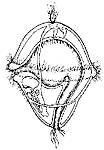
What is this?
|
trochophore larva
common to class Polycheata, Phylum Annelida |
|

what is it?
|
Euphausid
Order Euphausiacea Subclass Malacostraca Class Crustacea Subphylum Mandibulata Phylum Arthropoda |
|
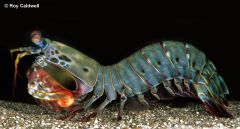
What is it?
|
Order Stomatopoda
Subclass Malocostraca Class Crustacea Subphylum Mandibulata Phylum Arthropoda |
|
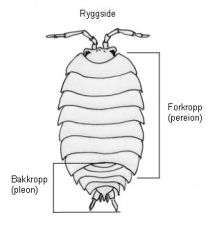
What is this
|
Order Isopoda
Subclass Malacostaca Class Crustacea Subphylum Mandibulata Phylum Arthropoda |
|
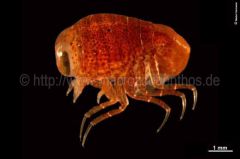
What is this?
|
Order Amphipoda
Sublass Malacostraca Class Crustacea Subphylum Mandibulata Phylum Arthropoda |
|
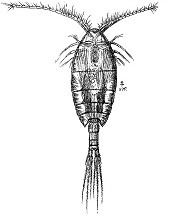
What is this?
|
Subclass Copepoda
Class Crustacea Subphylum Mandibulata Phylum Arthropoda |
|
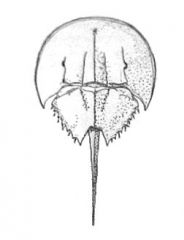
What is this
|
Class Merostomata
(horseshoe crab) Subphylum Chelicerata Phylum Arthropoda |
|
|
What subphylum is described by these characteristics? What is the most common member?
1. Absence of antennae 2. Body divided into two portions (prosoma and opisthosoma) with no distinct head 3. First pair of appendages, the chelicerates are adapted for eating 4. Lack mandibles |
Subphylum Chelicerata
Phylum Arthropoda most common member is the horeshoe crab (class Merostomata) |

